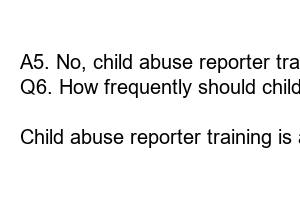아동학대 신고의무자 교육
Title: Enhancing Child Safety: The Importance of Child Abuse Reporter Training
Introduction:
Child abuse is a heart-wrenching reality, affecting numerous innocent lives worldwide. To address this grave concern, there is an urgent need for individuals to be adequately trained as child abuse reporters. By becoming proactive members of the community and educators on recognizing and reporting child abuse, we can help protect vulnerable children. In this blog post, we will delve into the significance of child abuse reporter training and how it plays a pivotal role in creating a safer environment for children.
1. What is Child Abuse Reporter Training?
Child abuse reporter training equips individuals with the necessary knowledge and skills to identify signs of child abuse, understand reporting protocols, and ensure the well-being of affected children. It helps in fostering a community-based approach, where trained professionals and volunteers play active roles in safeguarding children.
2. Unmasking the Signs of Child Abuse:
Understanding the signs of child abuse is crucial for effective intervention. Through comprehensive training, participants learn to recognize physical, emotional, and behavioral indicators of abuse, enabling them to act promptly and appropriately.
3. Reporting Child Abuse: A Moral Responsibility:
Reporting child abuse is not just a legal requirement but a moral responsibility. By training individuals to become efficient reporters, we can empower them to take the necessary steps in reporting suspicions or concerns, thus preventing further harm to the child.
4. Collaborating with Law Enforcement and Social Services:
Child abuse reporter training emphasizes the importance of collaboration with law enforcement agencies and social services. Effective communication and cooperation with these entities enhance the accuracy and efficiency of investigations, ensuring the child’s protection and facilitating their journey to safety and recovery.
5. Awareness and Prevention Programs:
Child abuse reporter training programs also emphasize the significance of proactive education and awareness campaigns. By equipping communities with the knowledge to identify potential abuse situations, we can work towards preventing child abuse before it occurs.
6. Empowering Communities and Individuals:
Through child abuse reporter training, communities and individuals are empowered to be actively involved in advocating for child protection. From parents, teachers, and healthcare professionals to volunteers, everyone can contribute to creating a safe and nurturing environment for children.
FAQs:
Q1. How can I get child abuse reporter training?
A1. Child abuse reporter training is often offered by organizations specializing in child welfare. Contact local child protective services, law enforcement agencies, or non-profit organizations in your area to explore available training options.
Q2. Is child abuse reporter training mandatory?
A2. While the requirement for child abuse reporter training may vary across jurisdictions, it is strongly recommended for anyone who works with or around children to undergo this training.
Q3. What are the legal protections for child abuse reporters?
A3. Many jurisdictions have laws in place to protect individuals who report suspected child abuse. These laws often prioritize the welfare of the child and provide immunity to reporters acting in good faith.
Q4. Can child abuse reporter training make a difference?
A4. Absolutely! Child abuse reporter training equips individuals with the skills and knowledge needed to identify and report child abuse effectively. By intervening early, countless children’s lives can be saved and transformed.
Q5. Is child abuse reporter training only for professionals?
A5. No, child abuse reporter training is available for a wide range of individuals, including professionals, caregivers, and concerned community members. It is designed to equip anyone with the necessary skills to identify and report child abuse.
Q6. How frequently should child abuse reporter training be refreshed?
A6. Refresher training is highly recommended to ensure individuals remain updated on current laws, reporting procedures, and emerging trends in the field of child abuse.
Summary:
Child abuse reporter training is an essential step towards safeguarding children from the horrors of abuse. By recognizing the signs, understanding reporting protocols, and fostering collaboration, individuals can become proactive reporters and advocates for child safety. Through awareness, prevention, and intervention, we can create a society that upholds the rights and nurtures the well-being of every child.

